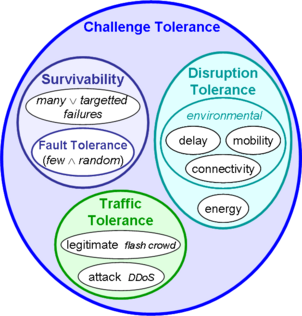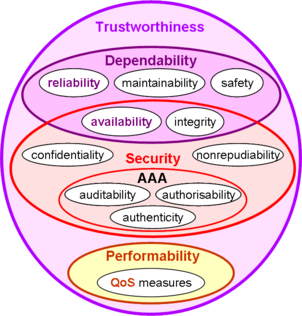Related Work
This page is structured and annotated list of papers and projects relevant to ResiliNets.
Each entry consists of:
- Reference (either project name or full bibliographic reference). The reference is a hyphen-separated list of author last names followed by a hyphen and the 4-digit year of publication, all enclosed in square brackets, e.g. [Doe-Smith-2006]. This reference is directly linked to a publicly and legally available paper, if available, or in some cases a project Web page. The author list is followed by a link to the DOI if available, and a link to a password-protected copy for use within the ResiliNets group. These latter two items are also within the square brackets, e.g. [Doe-Smith-2006 (doi) .] If you are not within the ResiliNets group, you'll have to find non-linked papers on your own, we regret that we can't email them.
- ResiliNets keyword list: our own small set of semi-standard keywords; in the case that a keyword is also on the Definitions page, it should be linked to the corresponding entry.
- Keyword list from the paper, if it has one; ACM subject headings should be removed.
- Abstract: copied from the paper and enclosed by quotation marks; may be shortened with ellipses [...] to note the omission.
- Notes: optional additional notes indicating the importance or context to ResiliNets, particularly when not obvious from the abstract
- A link to bibliographic entries
To upload documents to the wiki web server: You need to be on the ITTC network. Do *not* upload the file to the ResiliNets wiki directly!
For Linux users:
Open the document in pdf (by clicking on the hyperlink) Save the document as [lastname-2010.pdf] to the /projects/resilinets/website/internal/readings folder Change the read permissions of the document by <chmod 664 lastname-2010.pdf> in the /projects/resilinets/website/internal/readings Verify the update by opening the document on the wiki
For windows users:
Save the [lastname-2010.pdf] file to the /projects/resilinets/website/internal/readings folder
Related Disciplines
Resilience
Resilience is the ability of the network to provide and maintain an acceptable level of service in the face of various faults and challenges to normal operation. Resilient networks aim to provide acceptable service to applications.
Resilience subsumes a number of disciplines, many of which are tightly interrelated but have have developed separately, sometimes with inconsistent language. We broadly classify these disciplines into two major categories: those that are related to the tolerance of challenges and faults, and trustwortiness that considers aspects that can be measured. The two categories are related by the notion of robustness.
Disciplines Related to Faults and Challenges
Fault Tolerance
Fault tolerance is the ability of a system to tolerate faults such that service failures do not result. Fault tolerance generally covers single or at most a few random faults, and is thus a subset of survivability, as well as of resilience.
Survivability
Survivability is the capability of a system to fulfil its mission, in a timely manner, in the presence of threats such as targetted attacks or large-scale natural disasters resulting in many failures, in addition to the few random failures covered by fault tolerance. Survivability is thus a superset of fault tolerance but a subset of resilience.
Disruption Tolerance
Disruption tolerance is the ability of a system to tolerate disruptions in connectivity among its components. Disruption tolerance is a superset of tolerance of the environmental challenges: weak and episodic channel connectivity, mobility, delay tolerance, as well as tolerance of power and energy constraints.
- Challenged Environments and Energy Constraints
- Network types
- Sensor Networks
- Mobile Ad Hoc Networks
- Wireless Networks
- Wireless terrestrial LANs, MANs, and mesh networks
- Cellular Networks
- Mobile wireless telephony and data networks
- Satellite Networks
- Protocol Suites
Traffic Tolerance
Traffic tolerance is the ability of a system to tolerate unpredictable offered load without a significant drop in carried load (including congestion collapse), as well as to isolate the effects from from cross traffic, other flows, and other nodes. The traffic can either be unexpected but legitimate such as from a flash crowd or malicious such as a DDoS attack. [ResiliNets under construction]
Trustworthiness Disciplines Related to Quantifiable Properties
Dependability
Dependability is that property of a computer system such that reliance can justifiably be placed on the service it delivers. It generally includes the notions of availability (ability to use a system or service) and reliability (continuous operation of a system or service), as well as integrity, maintainability, and safety.
Security
Security is the property of a system and measures taken such that it protects itself from unauthorised access or change, subject to policy. Security properties include AAA (auditability, authorisability, authenticity), confidentiality, and nonrepudiation. Security shares with dependability the properties of availability and integrity.
Performability
Performability is that property of a computer system such that it delivers performance required by the service, as described by QoS (quality of service) measures.
Disciplines Relating Challenges to Metrics
Robustness
Robustness is the ability for a control system to maintain proper operation when input parameters are perturbed. In the context of resilience, it is the ability to maintain trustworthiness in the face of challenges.
Complexity
Network Architectures
Future Internet Architecture Proposals
Graph Theory
(more to be added)
Network Modeling
Network Topology
Random Failures Vs. Deliberate Attacks
Resilience in QoS
General Networking and Communication
Past Failures and Scenarios
Network Challenges
Natural Disasters
Failures of the Network Infrastructure
Failures of the Interdependent Infrastructure
Attacks against Physical Infrastructure
Attacks against Network Protocols and Software
Failures Resulting from Misconfiguration, Operational Errors, and Poor Design
Mechanisms and Algorithms to Support Resilience
We need to think how to structure this since there are several overlapping dimensions. A partial list of some of subsubheading is:
Programmable and Active Networks
Cross-Layer Optimisations and Functional Composition
Routing and Topology
[[Characteristics-Based Routing]
Uncategorised
(put new items here that you don't yet know where they go)
LGA ATC failure 8 June 2007 (http://www.philly.com/inquirer/business/20070615_Flight_delays_tied_to_old_computers.html)
ISS space station woes June 2007
Computer crash affecting world series ticket sales 22 October 2007 (http://sports.yahoo.com/mlb/news?slug=ap-rockies-seriestickets&prov=ap&type=lgns)
Sunk by Windows NT (http://www.gcn.com/print/17_17/33727-1.html)
Redundancy and Diversity
Transport Network Survivability
Late Binding to Destinations
Cartesian and Diffusion Routing
Miscellaneous and Unsorted
If it isn't obvious where a paper or project link goes, put it here to be sorted later.
Standards, Implementations, and Techniques
Router Redundancy
VRRP: Virtual Router Redundancy Protocol
HSRP: Cisco Hot Standby Router Protocol
CARP: Common Address Redundancy Protocol
Layer 3 and Layer 4 Readings
Transport
Basic and generic TCP Papers
Survey and Tutorial Papers
Congestion Control
TCP in wireless Environments
Landmark TCP Papers
Latest Cool Papers
Modeling TCP Papers
Web Service in MANETs
End-to-End FEC
End-to-End ARQ
Routing
Methodology
Simulation
ns-2
Routing Protocol Implementations


